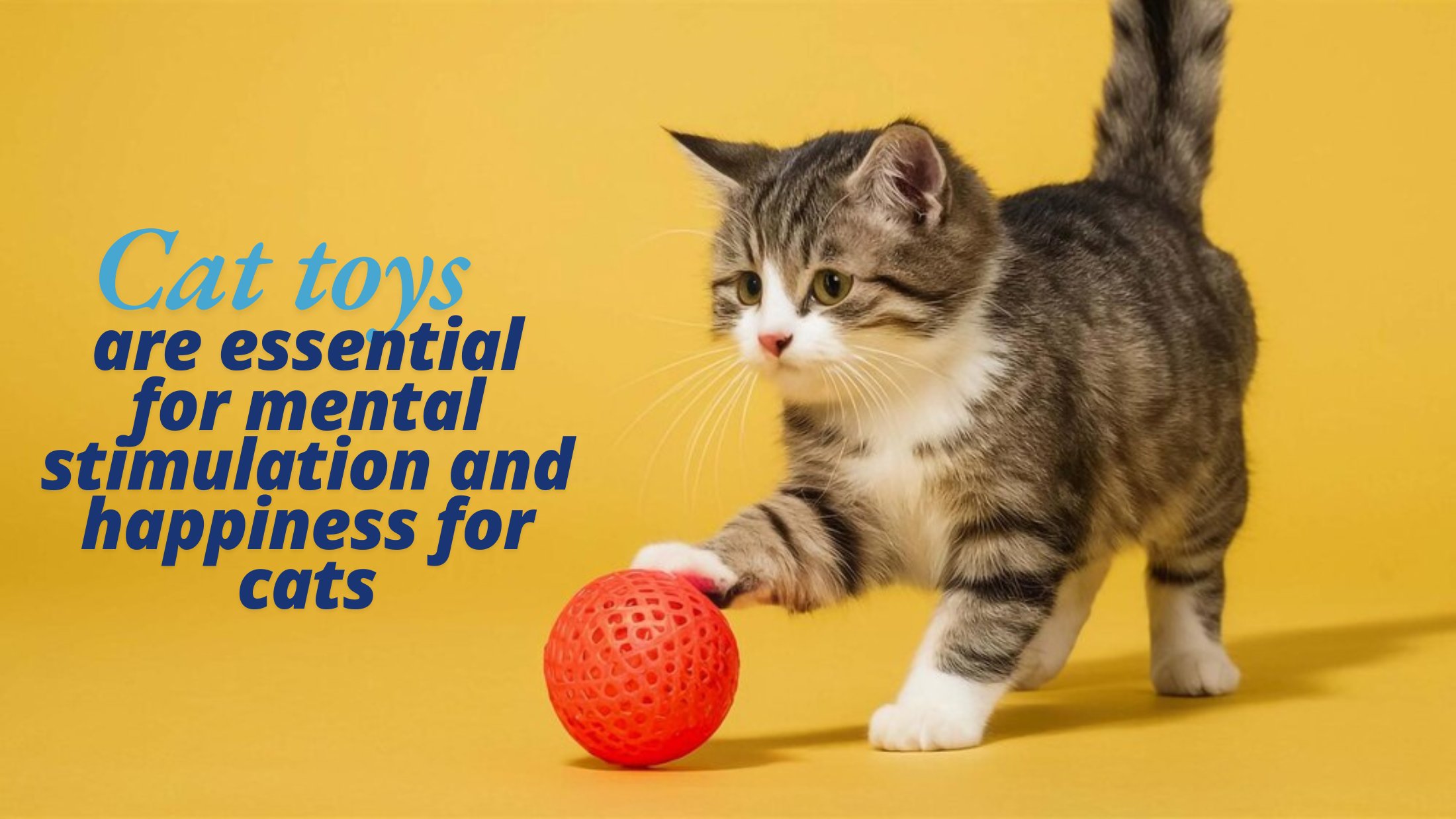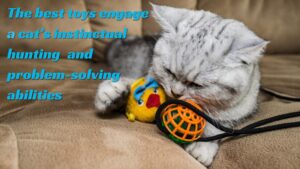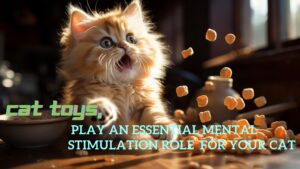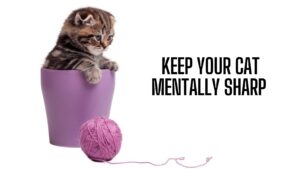“Cat toys” are critical for your feline friend’s mental stimulation and engagement. We all want our pets to live happy healthy lives as cat owners, but mental enrichment is often an afterthought. Like us, cats require activities that engage their minds in order to remain sharp and stave off boredom. Enter the “mental stimulation toys for cats.”
You can provide entertainment and mental challenges (to simulate their natural hunting instincts) for your kittens, young or senior cats with the right “cat toys.”
In this post, we will discuss some available options, such as interactive toys for cats, mental stimulation toys for cats, and several more creative alternatives to enhance your cat’s well-being.
We’ll also teach you how to choose the right toys for your kitty, to keep your feline mentally healthy and satisfied. Let’s take the plunge and learn how the right “cat toys” really can make all the difference!
Deeper Exploration of Mental Stimulation for Cats
Cats, especially those who are strictly indoors, are prone to boredom and mental under-stimulation. Being natural hunters, they have the desire for physical interaction and mental challenges that simulate their predatory instincts.
Cat mental stimulation toys are very important for keeping your feline happy, engaged and healthy. In this section, we’ll look at what “cat toys” does for your cat’s mental health and why you need to provide your cat with a range of stimulating play options.
The Importance of Mental Stimulation for Your Cat
Without adequate enrichment, a cat can develop some less-than-desirable behaviors, including over-scratching, overeating and aggression. The best “cat toys for mental stimulation” are, therefore, a mainstay in the fight against boredom. Similar to humans, cats require exercises to stimulate their brains to remain sharp and content.
Mental stimulation can decrease stress and anxiety, provide entertainment and help avoid behavioral problems. It also promotes “cat mental health” and helps them feel more secure, confident and relaxed.
Mental stimulation is especially important for the overall well-being of cats, especially if you have an indoor cat that doesn’t have much space to roam or explore.
How Do Cat Toys Keep Your Cats’ Mind Active
When it comes to mental stimulation, not all “cat toys” are created equal. The best toys engage a cat’s instinctual hunting and problem-solving abilities.
For example, “interactive toys for animals,” like treat puzzles or motion-activated toys, promote a style of play in which cats can engage their senses and logic to determine how to reach a reward, which simulates the types of challenges they would face in their natural environment.
These give your cat the thrill of victory, whether it’s completing a puzzle for a treat, or pouncing on a moving object that mimics an animal. This kind of playtime can provide a mental workout that is just as important as physical exercise.
You will want to provide a mix of “toys for energetic cats” as well as ones designed for mental stimulation to keep your cat both physically and mentally active.
Toys That Help Combat Boredom
If you’re searching for “how to entertain a bored cat”, the key involves presenting a balance of different toys that challenge their mind and their body. “Cat toys for indoor cats” in particular are essential, since indoor cats have less access to their environment compared to outdoor cats.
There are also interactive toys that involve some work from your cat to get their food or that move around randomly to keep your cat on alert, preventing boredom.
Examples of interactive toys for cats: Treat them with dispensing balls which are little balls that will release a little treat if your cat plays with them allows your cat to think or problem-solve.
These kinds of toys help keep your cat occupied and also keep their minds sharp, which is especially important if you have an older cat.
How to Pick the Right Toys to Stimulate Your Cat’s Mind
The following list of “cat toys” is by no means exhaustive, as each cat is unique and will have their own preferences. Some cats do well with energetic play with interactive cat toys, which simulate the thrill of the hunt, while others might enjoy more thoughtful, slow tell play, like puzzle toys.
Selecting appropriate toys for your cat can have a significant impact on their mental health and general contentment (opens in new tab).
For “energetic cats,” toys that promote movement and playing, such as feather wands or laser toys, will work well. If your cat enjoys a challenge, a treat puzzle or interactive feeder can be a great way to mentally stimulate your cat without requiring a lot of movements.
In conclusion, the key to your house cat’s mental health is to provide a variety of mental stimulation in the form of “cat toys.” Whether you’re combating boredom with “mental stimulation toys for cats,” or stimulating your cat’s hunting instincts with interactive toys for cats, these are elements vital to your cat’s mental and physical well-being.
Choosing the best cat toys for mental stimulation based on what type of games your feline friend enjoys and how energetic they are will help you enrich your cat’s life and take care of an even happier, healthier companion.
How Cat Toys Can Provide Mental Stimulation
“Cat toys,” play an essential mental stimulation role for your cat. Cats are smart and curious animals, so if they do not have the correct “cat toys” they may get bored, stressed, or even develop behavioral problems. So it’s no wonder that “mental stimulation toys for cats” are that important in a healthy, active lifestyle of your feline!
The most effective “cat toys” for mental stimulation are those that actively encourage your cat to use their problem-solving skills. “Interactive toys for cats” — treat-dispensing puzzles and puzzle feeders — force your cat to use problem solving skills to figure out how to get the treats inside.
These “cat toys” replicate the hunting process and harness your cat’s critical thinking and brain engaging skills in an exciting, rewarding way. These types of toys give your cat a mental workout that keeps them alert and centered, so you’re doing your cat a favor by providing such toys.
If you’re asking “how to entertain a bored cat,” then your cat needs a combination of “cat toys” for different senses and instincts. But one of the best at stimulating their minds is, for example, “cat toys for indoor cats.”
Unpredictably moving battery-operated motion toys and noise-making toys are great for keeping your feline stimulated and mentally challenged. These interactive cat toys help stimulate cats’ natural curiosity and hunting instincts while helping to prevent boredom.
Beyond interactive toys specifically designed for cats, there are also so-called mental stimulation toys for cats that require a little more time and thought put into them, including toys that use treats hidden inside or multiple steps to solve.
In addition to exercising your cat’s mind, these types of toys can help your cat learn how to focus and solve problems. If your cat is, as Mr. Vining describes his pet, “very energetic,” this sort of slow, thoughtful interaction can offer a mental challenge to counterbalance the physical challenges of ownership.
When it comes to “choosing the right toys for your cat” it is important to ensure there is a match between the toy and your cats personality and play style. For some of your indoor cats, “cat toys for indoor cats” that you use to keep them engaging in mind activity while getting their physical activity are spot on.
For others, more independent, solitary types of toys that require thought and strategizing may be a better choice. Whether generic or specially designed, mental stimulation is essential for your cat’s well-being.
Providing your cat with a selection of “cat toys” that exercise them mentally as much as physically can make all the difference in their quality of life!
Choosing the right mix of mental stimulation toys for cats and interactive toys for cats will help prevent boredom and keep your cat’s mind sharp and engaged, a much happier kitty overall.
How to Choose the Right Cat Toys
Finding the ideal “cat toys” to feed your pet can be difficult, especially with so many options available. However, the right “cat toys” can go a long way toward keeping your cat mentally stimulated, physically active and entertained.
Just make sure you spend some time thinking about the matter and you will quickly find the best toys that will match your cat’s preferences and requirements.
In “choosing the right cat toys”, it is important to take your cat’s age, personality and activity level into account. Younger cats, such as kittens, are rambunctious and should be provided with what is termed “interactive toys for cats” that promote both play and exploration.
Interactive playthings, like teaser wands or laser pointers, are ideal for promoting motion and interaction, which assist your kitten acquire both their bodily and psychological skills. As your kitten grows up, you can switch to more challenging “cats’ cognitive stimulating toys,” to develop their problem-solving skills.
For “more energetic cats”, it’s all about choosing toys that promote physical activity. More active cats enjoy toys that promote movement, like laser toys, ball tracks and climbing structures. These “cat toys” allow your cat to expend excess energy and stay mentally sharp.
If you like keeping your feline friend in a house, think of “cat toys for indoor cats” to keep them busy and going without needing access to the outdoors.
Other cats may prefer slower, more deliberate play. For cats that are more independent or not as active, consider mental stimulation toys for cats that require puzzle-solving or treat-dispensing. These “cat toys” challenge your cat’s brain and provide a satisfying challenge without as much physical exertion.
Matters are considered in the materials and the security of the “cat toys” you choose. Choose non-toxic and safe materials that your cat can play with, and materials that are strong and durable.
Do not buy any toys with small beans or balls that can pose a choking hazard, especially if your cat is a chewer or if they like to bat their toys around aggressively. Seek out high-quality “cat toys” that are created with your cat’s safety and well-being in mind.
Consider variety as another factor when “Choosing the right toys for your cat.” To help prevent boredom and keep them thinking, rotating your cat’s toys regularly is also a great idea.
A variety of toys — from interactive toys to treat puzzles to plain balls or stuffed animals — will help keep your cat’s mind active and getting their daily entertainment. Variety also discourages attachment to a single type of toy, ensuring that your cat has a richer, more varied play experience.
How much should you pay attention to your cat’s preferences? Others might prefer toys they can bat around with their paws; some cats are all about the thrill of pursuit.
Watch your cat’s response to various “cat toys” and select those that seem to excite your feline the most. Knowing your cat’s play style will help make sure you’re choosing toys that provide the best stimulation and enjoyment.
In summary, finding the perfect toys for your feline companion can involve some consideration and attentiveness. You may do so by choosing to include mental stimulation toys for cats and “interactive toys for cats” to help your cat stay occupied by considering its temperament, energy level, and interests.
Fortunately, with the right types of toys, you can keep your cat mentally agile, physically active and emotionally fulfilled, which will ultimately lead to a happier life for both you and your pet.
Creating a Mental Stimulation Playtime Routine
Establishing a daytime routine of play with the appropriate “cat toys” is the secret sauce to keeping your cat mentally stimulated and engaged. Just like humans, cats flourish on structure and routine, and a regular play schedule can alleviate stress, enhance behavior and encourage general happiness.
Including “mental stimulation toys for cats” within this daily routine can deliver just the right amount of fun and challenge, sharpening your feline’s cognitive skills and granting them an opportunity for crucial exercise.
How long you should set aside for play will depend on various factors and is the first step in building a successful playtime routine. Ideally, you want to have at least 15 to 30 minutes of interactive play daily, based on your cat’s age, energy level and preferences.
For “energetic cats,” playtime may be more frequent and longer while older or more independent cats may prefer shorter, more concentrated sessions. No matter what your cat’s needs may be, play is important to ward off boredom and keep them mentally sharp.
Another item to throw into your playtime supplies are “cat toys,” and when adding them to your kitty-playtime arsenal mix it up! Having lots of different types of mental stimulation toys for cats means that your cat is not bored with the same toys each day.
For example, you might begin the session with “interactive toys for cats” that include chasing or pouncing, such as laser pointers or feather wands. These toys help your cat burn off energy while providing mental exercise in a fun, interactive way.
Then, bring in toys that put your cat’s problem-solving skills to the test, like treat-dispensing balls or puzzle feeders. These “cat toys” are great for slowing down the pace of play and providing your cat with a mental workout.
These interactive toys require your kitty to “work” for their treats, mimicking natural hunting behavior and fostering cognitive function.
“Cat toys for indoor cats” play a vital role in this routine, as they can often simulate the wide range of activities a cat would typically do in nature. Interactive cat toys such as motion-activated devices or erratic movement toys will engage your indoor kitty’s mind in ways that roaming the wilds can’t.
These kinds of toys satisfy your cat’s curiosity and provide your cat with mental stimulation — which is especially important for indoor cats that can’t enjoy all of the environmental richness that outdoor cats experience.
You can always rotate your cat’s “cat toys” around every couple of days if you see them getting restless or bored with the same items. Providing novel or various “mental stimulation toys for cats” will help renew their interest and spice up every play time. You may also add new challenges step by step so that you do not overwhelm your cat but can keep them mentally stimulated.
It can also be important to interact with your cat during playtime. Take the time to engage with your cat instead of simply arranging toys for them to play with independently. Play with your cat in involving way, use interactive cat toys like wand toys. Using it to play will also reinforce your bond with your cat, associating positive experiences with playtime.
Lastly, be mindful of when you’re playing. Since cats are naturally most active at dawn and dusk times, adding play activity in those periods may help your kitty release pent-up energy and appreciate their routine even more.
Timing play sessions with your cat’s natural peaks of energy both assures that your “cat toys” get into the action, and that you are appealing to your cat’s interests.
To sum it up, planning mental stimulation playtime is a great way to keep your cat mentally fit, physically active, and emotionally satisfied. You can provide mental stimulation toys for cats and also interactive toys for cats, and maintain a regular schedule to keep your cat engaged.
Playtime with appropriate toys is one of the best strategies available to prevent boredom and to make sure your feline companions live a healthy, fulfilled life.
Troubleshooting: What to Do if Your Cat Doesn’t Like Their Toys
It can be a disappointment when your cat is not really interested in their “cat toys” at all, especially if you’re the one who went through the trouble of finding the ones that are right for them!! That said, every cat has a unique personality and preferences, so no product labeled “cat toy” was a success out of the gate.
If it appears your cat doesn’t enjoy their toys, there’s no need to panic — there are a number of things you can do to encourage engagement and make playtime more fun.
Assess the Type of Cat Toys
Not every “cat toy” is right for every cat. Some felines love chasing after toys while others like their options to be more interactive or mentally stimulating. If your cat ignores a toy, reflect on their personality and behavior.
For instance, “interactive toys for cats”, eg, wand toys, laser pointers, those would suit playful or high-energy cats that enjoy chasing and pouncing. “Mental stimulation toys for cats”, for example, puzzle feeders or treat-dispensing toys, are great for cats who like puzzles and need to keep their minds working.
“You want toys that engage your cat in ways they would normally be engaged if they were hunting,” says Dr. Becker, noting that for indoor-only cats, “cat toys for indoors cats” that mimic that behavior will be baby human catnip.
Toys that move around on their own or are motion-activated can capture your cat’s interest and stimulate their natural prey drive. If your cat is just not engaging with certain toys, it’s worth switching to a different type to find out what sparks their interest.”
Introduce Toys Gradually
Cats play differently than we do, and sometimes will need a little time to warm up to the new “cat toys” you consider bringing home. When you’ve just offered a new toy and your cat isn’t interested, try slowly integrating it into their routine.
Begin by placing the toy in your cat’s usual hanging around area, so they can have a sniff good and proper at its own pace. You will also see who owns the toy—it is a great way to entrap a cat by baiting the cat closer to where you are standing, using the toy to attract the attention of your felines as they will often mimic chasing prey in their natural form this will better appeal to their hunting instincts and boost their interest.
Rotate the Toys to Keep It Fresh
Many cat toys are available all the time, leaving cats with the potential of boredom (quickly) if they are tired of their current set. To maintain your cat’s intrigue, you may want to rotate its toys every few days.
Remove the toys they’ve become bored with and swap them for toys they haven’t played with in a while or new toys designed to engage their minds. This will create an even more exciting play experience and keep your cat from getting bored.
For “mental stimulation toys for cats”, regularly changing up the puzzles or challenges you set for your cats is a great way to maintain their interest. For example, some toys have multiple difficulty settings available, which can keep your cat mentally stimulated and avoid frustration.
Add Positive Reinforcement
The best and fastest way to motivate your cat is with treats as well– and we all know how much cats love them, so that will help them to appreciate their “cat toys” even more when working with positive reinforcement.
If you are using “interactive toys for cats” that dispense treats, try putting a small treat in the toy to attract their attention. For instance, put a treat in a puzzle feeder or a treat ball to get your cat to interact with the toy. The reward links the toy with the reward, and ensures that your cat will be more interested in the toy in the days to come.
If your cat does not show much interest in playing with their toys, try playing with them too. Gently coax them with the sound of your voice or move the toy back and forth a little.
Analyzing what you do with “cat toys for indoor cats” often requires this kind of encouragement, especially if they’re already used to being indoors and need a little help activating their instinct.
Check the Toy’s Appeal
If your cat seems uninterested in a toy after these initial novel plays, it may just not be something it finds enjoyable. “Cat toys” can be many shapes, sizes and textures, and what grabs one cat’s interest may be old news to another.
If your cat isn’t taking to a toy, give it one with a different texture or sound. Some cats are obsessed with catnip-filled toys, while others are more interested in squeaky toys or crinkle materials. Note what kind of toys your feline appears to favor most and make adjustments accordingly.
Ensure the Toy Is Safe and Comfortable
However, cats can also exhibit signs of avoidance of a toy if they feel that they are at risk or that it is not safe to interact with it. The cat toys you give him should be of non-toxic materials and of an appropriate size for your cat.
If the toy has small parts or sharp edges, some cats might be put off playing with it, while others may find toys too large, intimidating. Ensure that the toys are appropriate for your cat’s age, size, and energy level in order to get the most enjoyment and safety from them.
Playtime Should Be Positive and Fun
Remember that playtime should always be fun! I would definitely try a few of these, but if your cat is turning down their “cat toys“, steer clear of forcing them into engagement or they may end up having a negative pairing with the idea of play.
Instead, exercise patience and cultivate an atmosphere with a positive hold. Use your voice to praise them or present new toys playfully, with humor. Eventually your cat will probably interact a bit more with their toys most as they settle in and feel more confident.
So, if your cat doesn’t care which “cat toys” they have, here are some troubleshooting strategies you can try to get them excited for playtime again.
In this information, we will ensure that you have a good idea about how to rotate your toys, introduce “mental stimulation toys for cats“, and the importance of positive reinforcement to your cat in order to help improve the way your cat plays and engages with your feline.
Over time, as you use the right methods, try out different toys, and allow a bit of trial and error, you’ll uncover the toys that keep your cat’s mind sharp, their body active, and their heart/contentment happy
Cat Toy Safety: Avoiding Common Mistakes
Safety should always be the first priority when it comes to choosing “cat toys” Although it’s great to find your cat some mentally stimulating and engaging toys, you need to make sure they are safe to play with.
Selecting and using “cat toys” should be fun, but the wrong choice can easily lead to injury or stress for your cat and thus be damaging for the relationship between you. In this section, we’re going to go over a few common mistakes people make while shopping for “cat toys” and what you can do to ensure your feline is having a fun yet safe playtime.
Opting for Toys with Small, Detachable Pieces
Choosing “cat toys” with small bits that can easily be chewed off or swallowed is one of the top safety blunders. If your kitty munches on or consumes these components, they could face severe health crises like blockage in the intestines or digestive problems.
Choose toys made from sturdy, non-toxic materials without small, detachable parts. That might be especially important for cat interactive toys, though, with parts that may move or adjust. Keep your cat’s safety in mind when choosing toys, opting for ones specifically designed for their size and age.
Ignoring the Material Safety
You might also be making the mistake of not paying attention to the materials used in plastic stimulation toys. Toys may contain harmful substances such as lead, plasticizers, and dyes that can be ingested by cats.
Cheap, low-quality materials used in “cat toys” also can break apart easily, possibly leading your cat to swallow flaking-off parts that may be harmful, she says.It’s important to read the labels and select toys made with safe, non-toxic materials, like natural rubber, fabric or untreated wood.
For example, if you’re picking “cat toys for indoor cats”, ensure that materials are safe for the home environment. Felt, wool or organic cotton are all safer bets than plastic-y materials. Choose toys that are safe and devoid of toxic chemicals — even more so if your cat likes to chew on its toys.
Overlooking Toy Durability
Although it might be a no-brainer to purchase some of the cheap, seemingly “fun” cat toys, you absolutely need to think about durability for the rambunctious cats. In terms of safety, for active cats, choose cat interactive toys made for bumpy play.
Toys with strong, tightly bound stitching and components do not fall apart and are less likely to contain the types of materials your cat might inadvertently swallow. Check toys for wear and tear regularly and get rid of any that are falling apart or are unsafe to use.
Allowing Unsupervised Play with Certain Toys
Even with safe “cat toys,” supervision is crucial. Although a number of interactive toys (like strings, ribbons or small balls) can be played with independently, an accident can occur if your cat swallows one of them or gets caught.
You should always supervise playtime with certain toys, especially if they have long strings or tiny parts. If you’re working with toys such as wand toys or laser pointers, be sure to supervise to prevent your cat from inadvertently injuring themselves or damaging their environment. When playtime is done, you should store any little toys where they’ll be out of your cat’s reach.
Mistakes in Selecting Toy Sizes
A frequently overlooked error is purchasing “cat toys” that are either too small or too big for your kitty. Toys that are too small can be swallowed or get stuck in your cat’s throat, and toys that are too large can also be intimidating and difficult for your cat to play with successfully. Selecting the proper size is particularly critical for kittens or small breeds, as they may find larger toys difficult to use.
Make sure the cat mental stimulation toys you buy are the correct size for your cat’s mouth and paws. A tiny kitten may struggle with giant puzzle feeders or treat-distributing balls, for example, so you’ll want to start off with correctly sized toys and then increase the challenge as your cat matures. Choose toys that your cat can easily hold, bat around or chase.
Using Toys That May Cause Harm
Certain types of “interactive toys for cats” that depend on motors or electricity may be dangerous if used improperly, or if the device malfunctions. Always read the instructions on toys that have mechanical or electrical components, and check they are working before your pet uses them.
Then there are toys that require so much force to operate. Inappropriate toys that your cat has to bite/pull too hard on can injure their jaws or cause muscles to get too strained. Select toys that are soft on your cat’s body and are not used with a lot of force.
Conclusion & Additional Resources
Affirmatively, “cat toys” are vital for your cat health. Providing an assortment of toys that suit your cat’s instincts and personality gives them sorely needed mental stimulation and entertainment. Interactive toys for cats, mental stimulation toys for cats, “cat toys for indoor cats” — whatever your category, the right toy will keep boredom at bay, depression down and your cat healthy and happy.
Again, there is no best set of “cat toys”, you have to do what works for your cat when it comes to age, size, energy level, and preferences. Try different kinds of toys and make sure to set aside some play time each day to keep your cat entertained.
Be aware of toy safety, steer clear of common mistakes such as choosing toys with small removable parts, and regularly check your cat’s toys for wear and tear.
Of course, if you’d like to learn more about cats (and more specifically cat toys) and you want to make sure that you’re considering every suggestion out there, there are plenty of vet-recommended resources and articles out there that’ll help you get informed and make great decisions! Here are some supplementary resources that can help you select the best “cat toys” based on your cat’s individual needs.
Additional Resources:
- The Cat Fancier’s Association (CFA)
The CFA has resources for how to care for your cat, including how to choose the best kitty toys based on your cat’s personality and needs. Check out their website for resources on keeping your cat socially, mentally, and physically stimulated. Visit CFA Website. - Jackson Galaxy – Cat Toys and Enrichment Ideas
Jackson Galaxy, a well-known cat behaviorist, offers guidance on how to choose interactive toys for cats and create enriching play routines that enhance your cat’s mental stimulation and overall happiness. His resources are excellent for both new and experienced cat owners. Learn More with Jackson Galaxy - Chewy – Cat Toys Collection
Chewy is a great online resource for purchasing a variety of “cat toys”. They also offer user reviews and expert recommendations, helping you find the perfect toys for your cat. Check out their extensive collection of toys, including those designed for energetic cats or mental stimulation. Shop Cat Toys on Chewy
Using these tools, you can choose which cat toys would be the best fit for your cat. The best toys will not only be fun for you and them, but will also support your cat’s needs in terms of mental health, stress relief and destructive behavior prevention. With the right toys, you’ll be giving your cat a fun, challenging and safe playtime.






